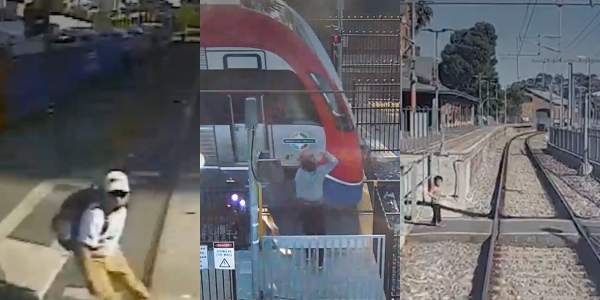Hair-raising videos reveal risky behaviours pedestrians are committing
By
Seia Ibanez
- Replies 18
As we navigate through our daily routines, safety should always be a top priority, particularly when it comes to interacting with heavy machinery and fast-moving vehicles.
However, recent footage from South Australia's railways paints a harrowing picture of how close some individuals come to disaster, engaging in risky behaviours that could cost them their lives.
The alarming compilation of videos online showcased a series of near-misses involving pedestrians and vehicles on South Australian train and tram lines.
With 173 incidents recorded, the footage is a stark reminder of the dangers present at railway crossings and along tracks.

One particularly distressing clip showed a young child wandering alone onto the tracks at a crossing in Gawler.
The child turned back mere seconds before a train arrived and halted, a heart-stopping moment for any onlooker.
This video, along with others, will be featured in a new state government campaign aimed at curbing reckless behaviour near rail networks.
Another video captured a man at Broadmeadows who brazenly jumped over an activated pedestrian gate, narrowly missing a speeding train by mere centimetres.
A third incident depicted a man stepping out in front of an oncoming tram, oblivious to the danger, and retreating just in time to avoid a catastrophic outcome.
The statistics are sobering: a typical passenger train, weighing in at 140 tonnes, requires 470 meters of track to come to a safe stop when the emergency brake is deployed at a speed of 110km/h.
Freight trains need even more distance, with a stopping requirement of 1 kilometre.
Earlier this year, these risks became a reality for some. An Adelaide father lost his life while crossing the tracks at Salisbury East, and a teenager was fatally struck at a pedestrian crossing in North Adelaide.
While the number of near-misses reported this year—123 involving trains and 50 involving trams—shows a slight decrease from last year's figures, SA Transport Minister Tom Koutsantonis's message is clear: risk-taking must stop.
The government's campaign, which will be disseminated across social media and television during Rail Safety Week, aims to reduce these incidents by urging the public to keep safety at the forefront of their minds.
'The vision released today shows just some of the shocking examples captured across our railways and should serve as an important and timely reminder to keep safety front of mind,' Koutsantonis stated.
'While these incidents did not result in tragedy, they did leave a lasting impact on the drivers and on public transport passengers who witness such near misses.'
 Have you witnessed any risky behaviour at train or tram crossings? What measures do you think could improve safety in these areas? Share your thoughts with us in the comments below.
Have you witnessed any risky behaviour at train or tram crossings? What measures do you think could improve safety in these areas? Share your thoughts with us in the comments below.
However, recent footage from South Australia's railways paints a harrowing picture of how close some individuals come to disaster, engaging in risky behaviours that could cost them their lives.
The alarming compilation of videos online showcased a series of near-misses involving pedestrians and vehicles on South Australian train and tram lines.
With 173 incidents recorded, the footage is a stark reminder of the dangers present at railway crossings and along tracks.

A compilation of videos online showed a series of near-misses involving pedestrians on tram lines. Credit: South Australia Government
One particularly distressing clip showed a young child wandering alone onto the tracks at a crossing in Gawler.
The child turned back mere seconds before a train arrived and halted, a heart-stopping moment for any onlooker.
This video, along with others, will be featured in a new state government campaign aimed at curbing reckless behaviour near rail networks.
Another video captured a man at Broadmeadows who brazenly jumped over an activated pedestrian gate, narrowly missing a speeding train by mere centimetres.
A third incident depicted a man stepping out in front of an oncoming tram, oblivious to the danger, and retreating just in time to avoid a catastrophic outcome.
The statistics are sobering: a typical passenger train, weighing in at 140 tonnes, requires 470 meters of track to come to a safe stop when the emergency brake is deployed at a speed of 110km/h.
Freight trains need even more distance, with a stopping requirement of 1 kilometre.
Earlier this year, these risks became a reality for some. An Adelaide father lost his life while crossing the tracks at Salisbury East, and a teenager was fatally struck at a pedestrian crossing in North Adelaide.
While the number of near-misses reported this year—123 involving trains and 50 involving trams—shows a slight decrease from last year's figures, SA Transport Minister Tom Koutsantonis's message is clear: risk-taking must stop.
The government's campaign, which will be disseminated across social media and television during Rail Safety Week, aims to reduce these incidents by urging the public to keep safety at the forefront of their minds.
'The vision released today shows just some of the shocking examples captured across our railways and should serve as an important and timely reminder to keep safety front of mind,' Koutsantonis stated.
'While these incidents did not result in tragedy, they did leave a lasting impact on the drivers and on public transport passengers who witness such near misses.'
Key Takeaways
- Alarming footage has emerged depicting dangerous close encounters between pedestrians and railway vehicles on South Australian railways.
- The state government is launching a new campaign to raise awareness about the risks and reckless behaviour of people around rail networks.
- There have been 173 incidents in the past year of near-misses involving trains and trams and pedestrians or vehicles.
- The Transport Minister emphasised the importance of safety, and the campaign aims to reduce the number of these near-misses through social media and television during Rail Safety Week.







